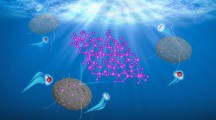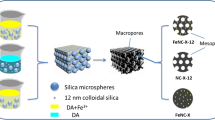Abstract
Thermal stability of carbon based materials is crucial to their catalytic performance in oxidative dehydrogenation at high temperature. This work aims at exploring the mechanism for B doping to improve thermal stability and catalytic performance of N, B co-doped carbon (HC-N-B) for oxidative dehydrogenation of propane using CO2, which was prepared by using humic acids (HAs) extracted from Sheng Li lignite. Porous carbon (HC) from humic acids has low thermal stability in CO2 and N-doping resulted in the decreased thermal stability of HC. Interestingly, B doping HC-N showed very high thermal stability in CO2 (almost no weight-loss). Thus, HC-N-B could be used as considerable stable carbon catalysts with high catalytic activity for oxidative dehydrogenation of propane using CO2. Compared to porous carbon (HC) and N-doping porous carbon (HC-N) from HAs, the HC-N-B could remain the high catalytic dehydrogenation activity in 5 h. It was found that B doping on the defect structure in carbon skeleton structure of the HC-N could greatly increase the thermal stability of surface defects of N-doped porous carbon in CO2, and molecular simulation calculation results further confirmed that the existence of C-N-B and BC3 structure in the carbon skeleton defects could act as catalytic active sites in dehydrogenation reaction, which could slightly enhance the catalytic activity of the HC-N-B and largely improved its catalytic stability of the HC-N-B.
Graphical abstract








Similar content being viewed by others
References
Vernikovskaya NV, Savin IG, Kashkin VN, Pakhomov NA, Ermakova A, Molchanov VV et al (2011) Dehydrogenation of propane-isobutane mixture in a fluidized bed reactor over Cr2O3/Al2O3 catalyst: experimental studies and mathematical modeling. Chem Eng J 181:158–164. https://doi.org/10.1016/j.cej.2011.05.115
Nawaz Z, Tang XP, Chu Y, Wei F (2010) Influence of calcination temperature and reaction atmosphere on the catalytic properties of Pt-Sn/SAPO-34 for propane dehydrogenation. Chin J Catal 31:552–556. https://doi.org/10.1016/S1872-2067(09)60071-1
Fukudome K, Suzuki T (2015) Highly selective oxidative dehydrogenation of propane to propylene over VOx-SiO2 catalysts. Catal Surv Asia 19:172–187. https://doi.org/10.1007/s10563-015-9192-4
Grant JT, Carrero CA, Goeltl F, Venegas J, Mueller P, Burt SP et al (2016) Selective oxidative dehydrogenation of propane to propene using boron nitride catalysts. Science 354:1570–1573. https://doi.org/10.1126/science.aaf7885
Drejc K, Blaž L, Matej H (2022) Metal-doped Cr2O3 as a catalyst for non-oxidative propane and butane dehydrogenation: a multiscale kinetic study. Appl Surf Sci 575:151653. https://doi.org/10.1016/j.apsusc.2021.151653
Matej H, Drejc K, David B, Blaž L (2021) Effect of surface oxidation on oxidative propane dehydrogenation over chromia: an ab initio multiscale kinetic study. ACS Catal 11:11233–11247. https://doi.org/10.1021/acscatal.1c01814
Luka S, Julija S, Nika T, Matej H, Drejc K, Blaž L (2020) Ab initio multiscale process modeling of ethane, propane and butane dehydrogenation reactions: a review. Catalysts 10:1405. https://doi.org/10.3390/catal10121405
Tinnakorn S, Supawadee N, Nawee K, Anchalee J (2018) Theoretical insight into catalytic propane dehydrogenation on Ni(111). J Phys Chem C 122(26):14678–14690. https://doi.org/10.1021/acs.jpcc.8b03939
Hu ZP, Chen C, Ren JT, Yuan ZY (2018) Direct dehydrogenation of propane to propylene on surface-oxidized multiwall carbon nanotubes. Appl Catal A 559:85–93. https://doi.org/10.1016/j.apcata.2018.04.017
Wei Q, Yan P, Dang SS (2018) Oxidative dehydrogenation on nanocarbon: insights into the reaction mechanism and kinetics via in situ experimental methods. Acc Chem Res 51:640–648. https://doi.org/10.1021/acs.accounts.7b00475
Cao L, Dai PC, Liu DD, Xin GU, Zhao XB (2019) Carbonyl groups modified graphite sheets catalyze oxidative dehydrogenation of propane to propene. J Inorg Mater 34:1187–1192. https://doi.org/10.15541/jim20190040
Qi W, Liu W, Guo XL, Schlögl R, Su DS (2015) Oxidative dehydrogenation on nanocarbon: intrinsic catalytic activity and structure-function relationships. Angew Chem Int 127:13886–13889. https://doi.org/10.1002/anie.201505818
Dai LM, Xue YH, Qu LT, Choi HJ, Baek JB (2015) Metal-free catalysts for oxygen reduction reaction. Chem Rev 115:4823–4892. https://doi.org/10.1021/cr5003563
Zhang J, Liu X, Blume R, Zhang AH, Schlögl R, Su DS (2008) Surface-modified carbon nanotubes catalyze oxidative dehydrogenation of n-butane. Science 322:73–77. https://doi.org/10.1126/science.1161916
Gao Y, Ma D, Wang CL, Guan J, Bao XH (2011) Reduced graphene oxide as a catalyst for hydrogenation of nitrobenzene at room temperature. Chem Commun 47:2432–2434. https://doi.org/10.1039/C0CC04420B
Guo YY, Cao CL, Luo FB, Huang BQ, Xiao LR, Qian QR et al (2019) Largely enhanced thermal conductivity and thermal stability of ultra high molecular weight polyethylene composites via BN/CNT synergy. RSC Adv 9:40800–40809. https://doi.org/10.1039/C9RA08416A
Mu XW, Yuan BH, Feng XM, Qiu SL, Song L, Hu Y (2016) The effect of doped heteroatoms (nitrogen, boron, phosphorus) on inhibition thermal oxidation of reduced graphene oxide. RSC Adv 6:105021–105029. https://doi.org/10.1039/C6RA21329D
Zhai XL, Liu JQ, Zhang YX, Fan QN, Li ZH, Zhou Y (2019) Microcrystal structure evolution of mesophase pitch-based carbon fibers with enhanced oxidation resistance and tensile strength induced by boron doping. Ceram Int 45:11734–11738. https://doi.org/10.1016/j.ceramint.2019.03.049
Wang J, Krishna R, Yang JF, Dandamudi KPR, Deng SG (2015) Nitrogen-doped porous carbons for highly selective CO2 capture from flue gases and natural gas upgrading. Mater Today Commun 4:156–165. https://doi.org/10.1016/j.mtcomm.2015.06.009
Fan ML, Pan XC, Lin WR, Zhang HN (2020) Carbon-covered hollow nitrogen-doped carbon nanoparticles and nitrogen-doped carbon-covered hollow carbon nanoparticles for oxygen reduction. ACS Appl Nano Mater 3:3487–3493. https://doi.org/10.1021/acsanm.0c00222
Roby S, Vidyanand V, Sreekumar K (2018) Synthesis of carbon nanosheets and nitrogen-doped carbon nanosheets from perylene derivatives for supercapacitor application. ACS Appl Nano Mater 1:4576–4586. https://doi.org/10.1021/acsanm.8b00888
Mostazo-López MJ, Krummacher J, Balducci A et al (2021) Electrochemical performance of N-doped superporous activated carbons in ionic liquid-based electrolytes. Electrochim Acta 368:137590. https://doi.org/10.1016/j.electacta.2020.137590
Liu YW, Zhang HY, Li XY, Wang LJ, Dong YZ, Li W et al (2021) Solvent-assisted synthesis of N-doped activated carbon-based catalysts for acetylene hydrochlorination. Appl Catal A 611:117902. https://doi.org/10.1016/j.apcata.2020.117902
Reitz C, Breitung B, Schneider A, Wang D, Lehr MVD, Leichtweiss T et al (2016) Hierarchical carbon with high nitrogen doping level: a versatile anode and cathode host material for long-life lithium-ion and lithium-sulfur batteries. ACS Appl Mater Interfaces 8:10274–10282. https://doi.org/10.1021/acsami.5b12361
Waralee D, Pongpon T, Nikom K (2020) Effects of nitrogen and oxygen functional groups and pore width of activated carbon on carbon dioxide capture: temperature dependence. Chem Eng J 389:124413. https://doi.org/10.1016/j.cej.2020.124413
Wang LC, Wang CH, Zhang ZW, Wu JH, Ding RM, Lv BL (2017) Thermal induced BCN nanosheets evolution and its usage as metal-free catalyst in ethylbenzene dehydrogenation. Appl Surf Sci 422:574–581. https://doi.org/10.1016/j.apsusc.2017.06.075
Gao M, Adachi M, Lyalin A, Taketsugu T (2016) Long range functionalization of h-BN monolayer by carbon doping. J Phys Chem C 120:15993–16001. https://doi.org/10.1021/acs.jpcc.5b12706
Wang GM, Wang P, Zhang XF, Wei QH, Wu SC, Xie ZL (2020) Nucleobase derived boron and nitrogen co-doped carbon nanosheets as efficient catalysts for selective oxidation and reduction reactions. Nanoscale 12:7797–7803. https://doi.org/10.1039/D0NR00516A
Yin J, Zhang DY, Zhao JQ, Wang XL, Zhu H, Wang CY (2014) Meso- and micro-porous composite carbons derived from humic acid for supercapacitors. Electrochim Acta 136:504–512. https://doi.org/10.1016/j.electacta.2014.05.115
Huang GX, Kang WW, Xing BL, Chen LJ, Zhang CX (2016) Oxygen-rich and hierarchical porous carbons prepared from coal based humic acid for supercapacitor electrodes. Fuel Process Technol 142:1–5. https://doi.org/10.1016/j.fuproc.2015.09.025
Qiao ZJ, Chen MM, Wang CY, Yuan YC (2014) Humic acids-based hierarchical porous carbons as high-rate performance electrodes for symmetric supercapacitors. Bioresour Technol 163:386–389. https://doi.org/10.1016/j.biortech.2014.04.095
Kudin KN, Ozbas B, Schniepp HC, Prudhomme RK, Aksay IA, Car R (2007) Raman spectra of graphite oxide and functionalized graphene sheets. Nano Lett 8:36–41. https://doi.org/10.1021/nl071822y
Zheng XL, Chen HN, Li Q, Yang YL, Wei ZH, Bai Y et al (2017) Boron doping of multiwalled carbon nanotubes significantly enhances hole extraction in carbon-based perovskite solar cells. Nano Lett 17:2496–2505. https://doi.org/10.1021/acs.nanolett.7b00200
Xiao SL, Luo F, Hu H, Yang ZH (2020) Boron and nitrogen dual-doped carbon nanospheres for efficient electrochemical reduction of N2 to NH3. Chem Commun 56:446–449. https://doi.org/10.1039/c9cc07708arsc
Song YL, Liu GS, Yuan ZY (2016) N-, P- and B-doped mesoporous carbons for direct dehydrogenation of propane. RSC Adv 6:694636–694642. https://doi.org/10.1039/c6ra20726j
Li JH, Shi C, Bao A (2021) Design of boron-doped mesoporous carbon materials for multifunctional applications: dye adsorption and CO2 capture. J Environ Eng 9:105250. https://doi.org/10.1021/ie302324b
Huang H, Wei XJ, Gao SY (2016) Nitrogen-doped porous carbon derived from malachium aquaticum biomass as a highly efficient electrocatalyst for oxygen reduction reaction. Electrochim Acta 220:427–435. https://doi.org/10.1016/j.electacta.2016.10.108
Yuan WF, Liu JL, Yi WJ, Liang L, Zhu YR, Chen XH (2020) Boron and nitrogen co-doped double-layered mesopore-rich hollow carbon microspheres as high-performance electrodes for supercapacitors. J Colloid Interface Sci 573:232–240. https://doi.org/10.1016/j.jcis.2020.03.126
Zhou H, Yi X, Hui Y, Wang L, Chen W, Qin Y, Wang M, Ma J, Hu XC, Wang Y, Hong X, Chen Z, Meng X, Wang H, Zhu Q, Song L, Zhen AG, Xiao FS (2021) Isolated boron in zeolite for oxidative dehydrogenation of propane. Science 372:76–80. https://doi.org/10.1126/science.abe7935
Zhang Y, Qi FS, Liu YJ (2020) Fabrication of high B-doped ordered mesoporous carbon with 4-hydroxyphenylborate phenolic resin for supercapacitor electrode materials. RSC Adv 10:11210–11218. https://doi.org/10.1039/D0RA00561D
Yang LJ, Jiang SJ, Zhao Y, Zhu L, Chen S, Wang XZ et al (2011) Boron-doped carbonnanotubes as metal free electrocatalysts for the oxygen reduction reaction. Angew Chem Int Ed 50:7132–7135. https://doi.org/10.1002/anie.201101287
Yang CP, Yin YX, Ye H, Jiang KC, Zhang J, Guo YG (2014) Insight into the effect of boron doping on sulfur/carbon cathode in lithium-sulfur batteries. ACS Appl Mater Interfaces 6:8789–8795. https://doi.org/10.1021/am501627f
Cao YL, Mao SJ, Li MM, Chen YQ, Wang Y (2017) Metal/porous carbon composites for heterogeneous catalysis: old catalysts with improved performance promoted by N-doping. ACS Catal 7:8090–8112. https://doi.org/10.1021/acscatal.7b02335
Rao RC, Dong HZ, Dong XZ, Tang YQ, Ni SW, Wu KX, Hu CM (2019) Defect-mediated hydroxylation of multi-walled carbon nanotubes as metal-free catalysts to enhance catalytic performance for oxidative dehydrogenation of ethylbenzene using CO2. J CO2 Util 31:8–15. https://doi.org/10.1016/j.jcou.2019.02.011
Rao RC, Ling Q, Dong HZ, Dong XZ, Li N, Zhang AM (2016) Effect of surface modification on multi-walled carbon nanotubes for catalytic oxidative dehydrogenation using CO2 as oxidant. Chem Eng J 301:115–122. https://doi.org/10.1016/j.cej.2016.04.109
Zheng FC, Liu D, Xia GL, Yang Y, Liu T, Wu MZ et al (2017) Biomass waste inspired nitrogen-doped porous carbon materials as high-performance anode for lithium-ion batteries. J Alloys Compd 693:1197–1204. https://doi.org/10.1016/j.jallcom.2016.10.118
Li LQ, Yang HB, Miao JW, Zhang LP, Wang HY, Zeng ZP et al (2017) Unraveling oxygen evolution reaction on carbon-based electrocatalysts: effect of oxygen doping on adsorption of oxygenated intermediates. ACS Energy Lett 2:294–300. https://doi.org/10.1021/acsenergylett.6b00681
Zhou YL, Yan W, Yu XY, Chen TT, Wang SR, Zhao WG (2020) Boron and nitrogen co-doped porous carbon for supercapacitors: a comparison between a microwave-assisted and a conventional hydrothermal process. J Energy Storage 32:101706. https://doi.org/10.1016/j.est.2020.101706
Sun L, Tian CG, Fu Y, Yang Y, Yin J, Wang L et al (2014) Nitrogen-doped porous graphitic carbon as an excellent electrode material for advanced supercapacitors. Chemistry 20:564–574. https://doi.org/10.1002/chem.201303345
Jug K (1973) A new definition of atomic charges in molecules. Theor Chem Acta 31:63–73. https://doi.org/10.1007/BF00527439
Xu XQ, Wang YG, Chen ZD, Bai L, Zhang KJ, Yang SS (2015) Influence of cooling treatments on char microstructure and reactivity of shengli brown coal. J Fuel Chem Technol 43:1–8. https://doi.org/10.1016/S1872-5813(15)60005-6
Lundberg M, Borowski T (2012) Oxoferryl species in mononuclear non-heme iron enzymes: biosynthesis, properties and reactivity from a theoretical perspective. Coord Chem Rev 257:277–289. https://doi.org/10.1016/j.ccr.2012.03.047
Gece G, Bilgic S (2012) Molecular-level understanding of the inhibition efficiency of some inhibitors of zinc corrosion by quantum chemical approach. Ind Eng Chem Res 51:14115–14120. https://doi.org/10.1021/ie302324b
Acknowledgements
This work is financially supported by the National Key Program for International S&T Cooperation Projects of China (No. 2017YFE0124300), University Natural Science Research Project of Anhui Province (KJ2017A056) and Innovative Research Group Project of the National Natural Science Foundation of China (Grant No. 21776002)
Author information
Authors and Affiliations
Corresponding author
Ethics declarations
Competing interests
The authors declare the following financial interests/personal relationships which may be considered as potential competing interests.
Additional information
Publisher's Note
Springer Nature remains neutral with regard to jurisdictional claims in published maps and institutional affiliations.
Supplementary Information
Below is the link to the electronic supplementary material.
Rights and permissions
About this article
Cite this article
Ling, Q., Wu, R., Wang, Zh. et al. Promotion role of B doping in N, B co-doped humic acids-based porous carbon for enhancing catalytic performance of oxidative dehydrogenation of propane using CO2. Reac Kinet Mech Cat 135, 1785–1802 (2022). https://doi.org/10.1007/s11144-022-02251-5
Received:
Accepted:
Published:
Issue Date:
DOI: https://doi.org/10.1007/s11144-022-02251-5




